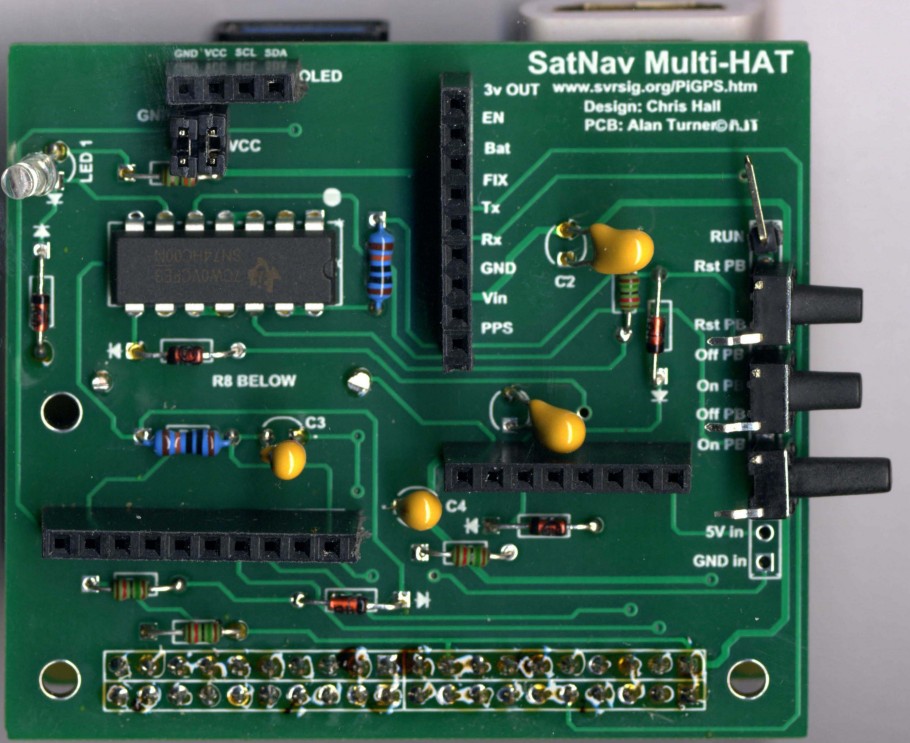SatNav updated
|
|
A slight tweak to the software to improve the OLED display while downloading a log to USB stick takes the software from version 2.30 to 2.50 but the change is minimal and the latest version will be uploaded after tonight’s Bristol group meeting. The final version of the hardware has been upgraded from a breadboard approach to use a custom built PCB and will be on display at the Wakefield show. Fitted with a 4400mAh LiPo battery, the unit consumes about 175mA and thus gives a battery life of about 15 hours. Current consumption whilst shutdown is about 25µA. Bare PCBs will be available for sale:
The information for the forthcoming Wakefield show has been updated. The final version now uses four plugin modules: a GPS module which deals with the satellite GPS signals; an OLED display module which provides a display in lieu of an HDMI monitor; an analogue to digital module which allows voltages to be measured and a power boost board which allows the unit to be run from a battery. The problem with a breadboard approach is that wiring it up is tedious and error prone. Previous versions used intricate wiring on a breadboard that required enormous patience (not my strong point) and much correction of minor wiring errors. It is a good approach while each unit is breaking new ground but once a design is finalised there is a huge I worked out that there was (just) enough space on a 68mm x 60mm PCB to mount all four modules, each with a header socket and the few components with plenty of space around each for soldering. I designed this to be a ‘multi-HAT’ board, accommodating the four modules and plugging in to a Pi Zero. I laid out an approximate design for the PCB on 28 April and with some considerable help from a colleague who knew how to specify PCBs we reached a consensus on the design (version 7) by 4 May and I ordered it from China the same day. It was delivered on 9 May. Pretty good service! The ‘Mulit-HAT’ board can now be tested with no ancillary boards plugged in (supplying power directly to the micro |
|
|
SatNav is one of my favourite apps since it works so well with RiscOSM on my Pi-Top. I would like to use SatNav with RiscOSM on my PineBook laptop (and hopefully sometime soon with the PineBook Pro). Is there any chance that SatNav will be adapted to work with a USB GPS receiver? |
|
|
Is there any chance that SatNav will be adapted to work with a USB GPS receiver? At present SatNav examines the serial port using the code below. It should be possible to adapt – how are the NMEA sentences obtained over USB? SatNav does not send any data to the GPS module, just expects it to stream serial data continuously at a default baud rate (its defalt mode). |
|
|
I am not sure how to include code fragments so forgive me for a minimal code fragment. My USB GPS receiver is a PL2303 device so I use Colin’s SerialUSB module. |
|
|
I am considering splitting off the various bits of SatNav which perform specific tasks with hardware. driving a PaPiRus via SPI; For the moment I’ll leave it as a single app. Do you have to issue a ‘CLOSE in%’ command at all? I’ll have a look at incorporating it next month sometime … |
|
|
Great news that you are interested in adapting your software to include USB GPS receivers. Yes you need to ‘CLOSE#in%’ |
|
|
G% = 0 STRING$="" WHILE G% <> 10 G%=BGET#in% IF G% <> 10 STRING$ += CHR$(G%) ENDWHILE This looks like a substitute for |
|
|
@Steve great question, yes GET$#in% works with a serial stream from this type of device and so saves some lines of code. |
|
|
GPS modules that use multiple satellite sources, for example GPS and GLONASS, transmit extra NMEA sentences that SatNav 2.50 does not understand. I am working on the next version that will work with such sources. My testing at the moment uses an Adafruit GPS ultimate module (5440) in place of the previous (740) on a machine with a 800×480 touch screen, OLED display, power control and Lithium Polymer battery. It consumes 700mA so the battery life is down to about 2½ hours. The updated GPS module now uses both American (GPS) and Russian (GLONASS) satellites. The NMEA sentences are different and so it can ‘see’ the GPS satellites but doesn’t get a fix as the GPRMC messages are sent as GNRMC. So I have been chasing three problems – the device would not turn off as I had forgotten to solder one end of R4; the OLED display would not work as I had not soldered the GND pin; the device would get a fix but be unable to communicate this to SatNav. Chasing three problems at once seems to take a very long time …. SatNav is now at version 2.52 and available from !Store. |
|
|
SatNav has been updated to version 2.54 and is available from !Store. This now allows USB-connected GPS modules (default speed 9600 baud) so will work, for example, on the Pinebook and Pinebook Pro. |

